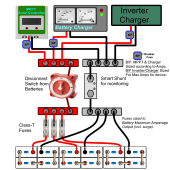I am all new to the solar world. In my cabin which I just bought I have 2 300W panels = 600W. At the moment, these are connected to a 12V | 80Ah car battery. I was wondering if its somehow possible to charge multiple of those batteries by putting more batteries in series.
What I want is to charge multiple batteries one after the other and also take the power from them one after the other. I saw videos where it was done that way, just not sure if it needs more equipment or if I missed something.
Thanks for helping a newbie !
!
What I want is to charge multiple batteries one after the other and also take the power from them one after the other. I saw videos where it was done that way, just not sure if it needs more equipment or if I missed something.
Thanks for helping a newbie



